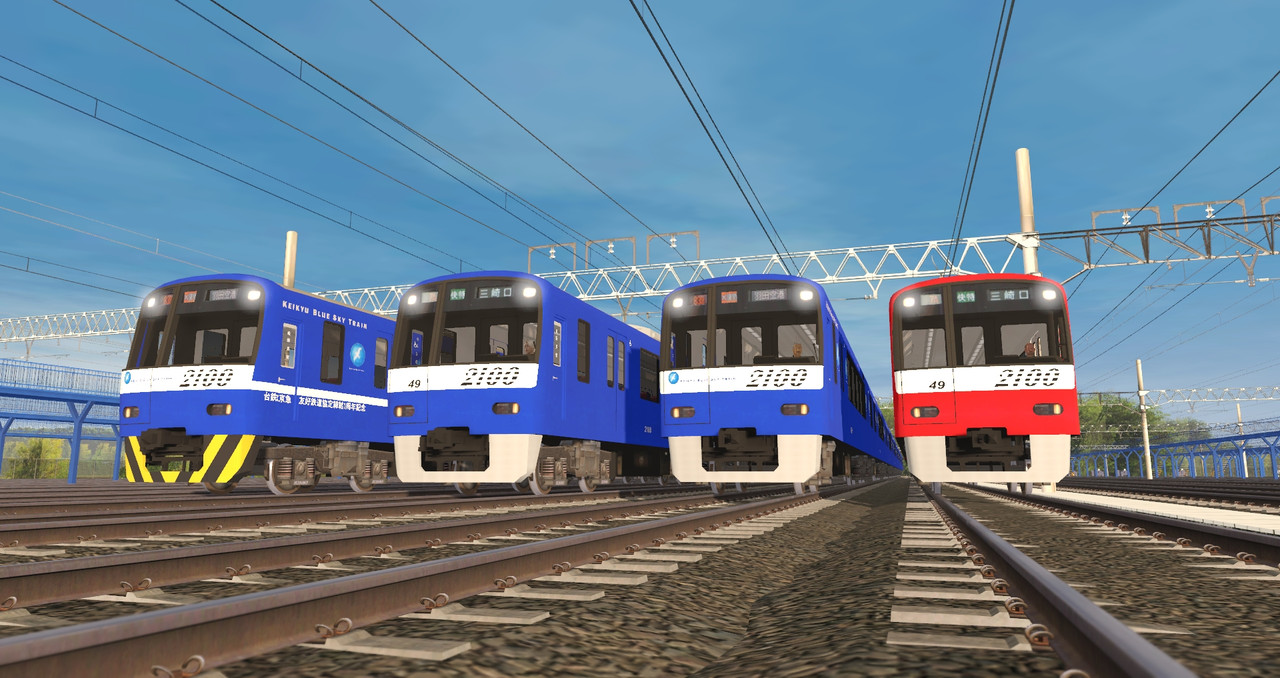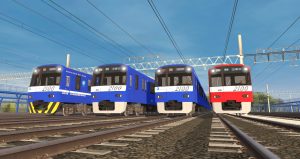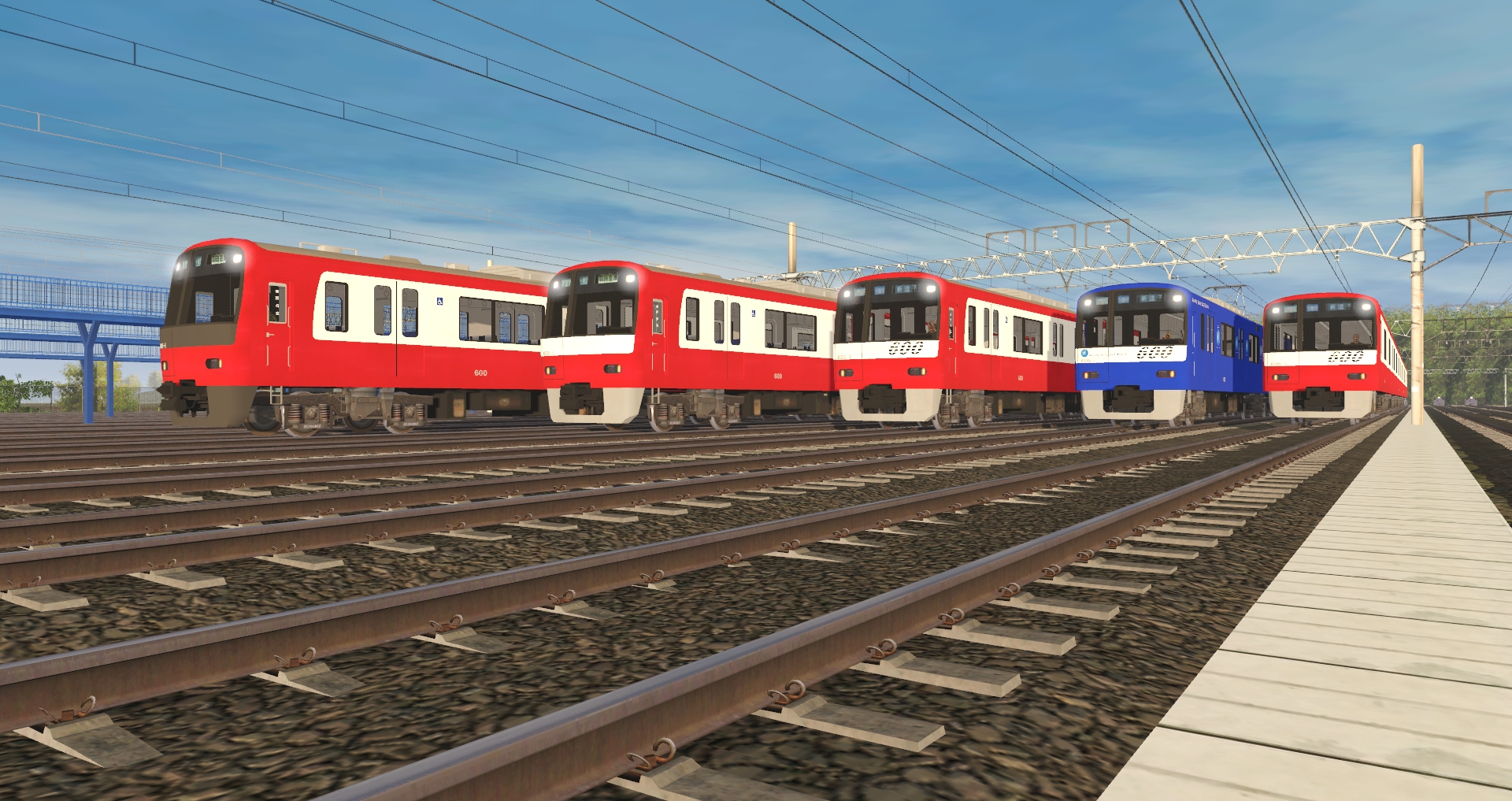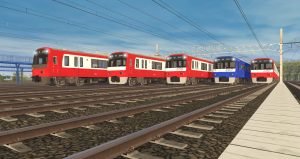Well, good evening evryone! After a nearly five-months hiatus, as i was in an internship in France, i'm back doing new content for Trainz!
And to make up for the long time since my last release, the "New Year's Pack", i've prepared something that i'm sure will be quite popular, even for those that are normally uninterested in commuter trains!
I'm honestly surprised that nobody made it before me, but here it is - the iconic "singing train" - Keikyu's 2100 Series!
Right to left: standard iconic "Keikyu Red" color scheme and then three "Keikyu Blue Sky Train" versions, always in order from right to left: "standard", "ex-Blue Sky Train" and the Keikyu-TRA (Taiwan) "sister railways agreement first anniversary" wrap.
Already available on my website!
DOWNLOAD All the necessary dependencies are either included in this package or are avaible on the DLS. Soundscript by Rizky_Adiputra. (Consists are included! Don’t bother with placing individual cars!) The 2100 Series was introduced by Keikyu at the very end of the 1990s as it’s new...

www.socimi.it
Of course, first of all, the most important thing:
Q:
Does it have
the thing?
Now, the 2100 Series was introduced by Keikyu at the very end of the 1990s as it's new "flaghsip", specifically designed and intended to be used on the highest-end services over the Keikyu network - express trains.
At the time Keikyu's express fleet was exclusively formed of the 2000 Series, twelve sets (six eight-car sets and six four car set, the latters running normally coupled in normal service) built between 1982 and 1987 by Tokyu Car and Kawasaki Heavy Industries. Depsite being very recent for the 1990s, with a good portion of the sets barely 10 years old, the 2000 Series had nonetheless suffered precocious wear from the intense express services it was assigned to, a situation made worse by their conventional carbon-steel construction, wich easily and rapidly rusted due to the salty air blowing inland from the sea, as almost all of Keikyu's lines are located within short distance from the seashore.
Furthemore, as it was designed without a front emergency door, the 2000 Series was not allowed north of Shinagawa and into the underground Sengakuji station, where non-trough-running services had a dedicated set of platforms to enable a smooth near-cross-platform interchange with the Toei Asakusa Line (Sengakuji station and the trackage from it to Shinagawa actually belongs to Toei, not Keikyu, thus subway rules apply - including the mandate for a front emergency escape door).
For all these reasons, plus a desire to modernize it's own image, in the mid-1990s Keikyu decided to embark in the design of an entirely new dedicated express train.
The base bodyshell design was first of all based entirely on the 600 Series, then Keikyu's newest commuter train, wich had just been introduced. Essentially the 600 Series bodyshell, made out of rust-proof aluminum alloy, with it's lovely rounded front, was taken "as it was" and "repurposed" for the new trains, with the only modification being the elimination of the central doors, leaving only two pairs at either end (the same identical configuration as used in the 2000 Series).
The color scheme was likewise never a question - Keikyu's scarlet red as a background and a cream white fascia around the passenger windows, again, nearly exactly the same one as the 2000 Series.
However, past the seemingly mundane bodyshell design and color scheme, Keikyu went all out in terms of interior fittings and equipment, seeking the fanciest and most refined "furniture" available.
Especially notable are the seats, designed in Norway by the Georg Eknes company (a renown manufacturer of seating for airliners, ships and european railway companies) with a distinctive lapis-lazuli blue with scarlet red polka dots upholstery designed in Sweded by the Bogesunds company (another renown manufacturer of seating for railway and pubblic transit agencies). Another notable fetaure of these seats is that they are "convertible" - that is, following the standard Japanese practice to have all seats in express trains face the direction of travel, the seats in Keikyu's new express trains could be rotated at terminuses so that they could face the new direction of travel. An important part of this is that the seats could be rotated pneumatically at the same time by using a switch located in the drivers' cab, drastically reducing the time needed for the operation down to a few seconds, whereas before, (such as on the 2000 Series) the conductor (or a platform attendant) had to manually rotate evry single seat.
Foldable seats, another unusual fetaure for Japan, were also installed near the two pairs of passenger doors. Normally locked in the "upright" position during rush hour, during quieter times they could be unlocked by the conductor using another switch located inside the driving cab. A light on top of each foldable seat would tell a "perspective seater" if the seat is unlocked and thus foldable open or not.
Other notable interior fetaures are the paneling and flooring, with a marble motif and the gangway door, built with an unusual honeycomb structure (hidden under the same marble-style paneling) in order to save weight.
Keikyu looked to fancier and refined overseas products even for more "technical" matters, landing a contract with two german companies: Knorr-Bremse for braking-related equipment (specifically an SL-22 endless-screw compressor) and Siemens, for traction-related equipment, leading to the most iconic fetaure of these trains - their "solfege" melody when departing.
Indeed their most iconic fetaure is their GTO-VVVF inverter, type G1450 D1130 / 560 M5-1, manufactured by Siemens in Germany, and based on the company's excellent SIBAS32 technology (SIBAS meaning Siemens Bahn-Automatisierungs-Systeme - "Siemens Railway Automation System"), with the most notable trait of this family of inverters being their frequency switching "melody", wich is formed of a near-perfect solfége with well-distinct notes (Fa - Sol - La - Si - Do - Re - Mi - Fa - Sol).
Already relatively commonplace in Germany (on the Class 401 locomotives for ICE1 sets and on the ES64P prototype of the successful "EuroSprinter" family), this was actually not the first time the "singing inverter" had been brought to Japan - indeed, JR East's E501 Series (a multi-voltage 209 Series derivative built for the Joban Line) had already been fitted with Siemens inverters upon it's introduction in 1995.
Be as it be, this is certainly an "odd" choice, as all major domestic traction equipment manufacturers (Hitachi, Mitsubishi Electric and Toyo Denki) were already well acquainted with inverters, having supplied them to a large selection of railway companies since the mid-1980s. This can be explained one way with Keikyu (and JR East) looking for a better quality-price match outside the domestic market. While for JR East this was to be a very small, one-time thing, for Keikyu it would become a relatively long-term relationship with Siemens, as the company opted for the same Siemens-made GTO-VVVF inverters for the first and second batches of it's New 1000 Series commuter trains, built in 2002 and 2003, and would keep using Siemens technology, albeit this time IGBT-VVVF inverters, for the subsequent third, fourth and fifth batch of the same series, built up until 2006, before reverting (permanently) to domestic manufactuers from the 7th batch onwards.
Christened as the "2100 Series", officially after the soon-to-be 21st century (and as part of the commemoration of the 100th anniversary of Keikyu, after the 1899 opening of today's Daishi Line by the Daishi Electric Railway, Keikyu's most direct "ancestor), but working also as a nod to it's role as a successor to the 2000 Series, the new express trains were adorned with a stylish rendition of the series designation on the fronts, with a italics "2100" broken by horizontal lines. Unlike what someone would normally expect, that is - a mundane print, the number is actually perforated into the white front portion, wich is none other than a cover for the windshield wipers (and thus is empty behind).
In total, ten 8-car sets were manufactured by Tokyu Car Co. and Kawasaki Heavy Industries (the same manufactuers as the 2000 Series) between 1998 and 2000 in four batches, split equally between the two manufacturers: Tokyu Car Co. would handle the first two batches (five sets) and Kawasaki Heavy Industries would handle the latter two batches (also five sets).
The first batch consisted of two sets, 2101F and 2109F, delivered on the 9th of February and 4th of March 1998. These were initially delivered devoid of the "perforated" 2100 numbering in the front, and were retrofitted with it upon delivery of the second batch.
Said second batch consisted of three more sets, 2117F, 2125F and 2133F, delivered on the 27th of October, 19th of October and 2nd of November 1998 respectively - one notable change in these was the "reinforcment" of the seats located right behind the windowed partition with the driving cab, so that passengers (meaning children) could lean onto them without too much damage.
These were followed by three more sets, 2141F, 2149F and 2157F, delivered on the 19th of April, 17th of May and 21st of May 1999, wich introduced car numbers on the front emergency door, but only the two latter "relevant digits" (for example, for car 2149 of formation 2149F, only a "49" would be displayed- there was no need to add each time "21" as well, among other things because the "perforated" designation number made any doubt regarding the series designation nill). Finally, the last two sets, 2165F and 2173F, were delivered on the 30th of October and 8th of November 2000, bringing the fleet to eight cars.
All the small differences between batches however disappeared immediately, as all trains were uniformed to the "style" of the last batch within a few months of delivery.
[continues in following post]

 JR 103 ex Wadamisaki Line by Muhammad Quraisy, on Flickr[/URL]
JR 103 ex Wadamisaki Line by Muhammad Quraisy, on Flickr[/URL]




